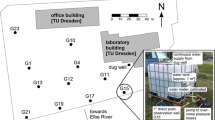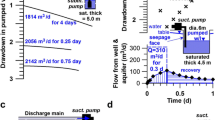Abstract
A groundwater flow and contaminant transport model was used to simulate arrays of non-pumped wells with reactive media for remediating contaminated groundwater. Each array featured a minimum number of wells, with identical diameter, capable of removing a contaminant plume within a hypothetical site. Simulated well diameters ranged from 0.25 m (similar to typical remediation wells) to 1.25 m (similar to large-diameter, bucket-augered wells). Both arrays occupied a linear transect located approximately 5 m downgradient of the front of a polluted enclave and oriented 90° to the hydraulic gradient. The minimum smallest diameter array contained 23 wells, whereas the minimum largest diameter array contained only four wells. Results of this study suggest that bucket-augering technology, adapted to install non-pumped wells with reactive media, may be an effective alternative for remediating contaminated groundwater in some environments.



Similar content being viewed by others
References
API (American Petroleum Institute) (1989) Hydrogeologic database for ground water modeling. American Petroleum Institute, Washington, D.C
Blowes DW, Ptacek CJ, Benner SG, McRae CWT, Bennett TA, Puls RW (2000) Treatment of inorganic contaminants using permeable reactive barriers. J Contam Hydrol 45(1):123–137
Bortone I, Di Nardo A, Di Natale M, Erto A, Musmarra D, Santonastaso GF (2013) Remediation of an aquifer polluted with dissolved tetrachloroethylene by an array of wells filled with activated carbon. J Hazard Mater 260:914–920
Byung L, Park E, Um J, Lee K, Jeong J, Nam K (2013) Release characteristics of molasses from a well-type barrier system in groundwater: a large test tank study for nitrate removal. Environ Earth Sci 70(1):167–174
Elder CR, Benson CH, Eykholt GR (2002) Effects of heterogeneity on influent and effluent concentration from horizontal permeable reactive barriers. Water Resour Res 38(8):1152. doi:10.1029/2001WR001259
Flury B, Frommer J, Eggenberger URS, Mader URS, Nachtegaal M, Kretzschmar R (2009) Assessment of long-term performance and chromate reduction mechanisms in a field scale permeable reactive barrier. Environ Sci Technol 43:6786–6792
Guerin TF, Horner S, McGovern T, Davey B (2002) An application of permeable reactive barrier technology to petroleum hydrocarbon contaminated groundwater. Water Res 36(1):15–24
Hemsi PS, Shackelford CD (2006) An evaluation of the influence of aquifer heterogeneity on permeable reactive barrier design. Water Resour Res 42:W03402. doi:10.1029/2005WR004629
Hudak PF (2008) Configuring passive wells with reactive media for treating contaminated groundwater. Environ Prog 27(2):257–262
Hudak PF (2012) Relative efficiency of multi-transect, non-pumped, reactive well networks for removing contaminated groundwater. Toxic Hazard Subst Environ Eng 47(13):2159–2162
Hudak PF (2014) Comparison of permeable reactive barrier, funnel and gate, non-pumped wells, and low-capacity wells for groundwater remediation. J Environ Sci Health 49(10):1171–1175
Lai KCK, Lo IMC, Birkelund V, Kjeldsen P (2006) Field monitoring of a permeable reactive barrier for removal of chlorinated organics. J Environ Eng 132(2):199–210
Painter BDM (2004) Reactive barriers: hydraulic performance and design enhancements. Gr Water 42(4):609–619
SDDENR (South Dakota Department of Environment and Natural Resources) (2003) Standard operating procedure nine: drilling methods. South Dakota Department of Environment and Natural Resources, Pierre
USGS (U.S. Geological Survey) (1999) Deep aquifer remediation tools (DARTs): a new technology for ground-water remediation. U.S. Geological Survey Fact Sheet, Reston, pp 156–199
Vermeul VR, Szecsody JE, Fritz BG, Williams MD, Moore RC, Fruchter JS (2014) An injectable apatite permeable reactive barrier for in situ 90Sr immobilization. Groundw Monit Remediat 34(2):28–41
Wilson RD, Mackay DM, Cherry JA (1997) Arrays of unpumped wells for plume migration control by semi-passive in situ remediation. Gr Water Monit Remediat, Summer, pp 185–193
Zheng C, Wang PP (1999) MT3DMS, A modular three-dimensional multi-species transport model for simulation of advection, dispersion and chemical reactions of contaminants in groundwater systems documentation and user’s guide. U.S. Army Engineer Research and Development Center Contract Report SERDP-99-1, Vicksburg
Author information
Authors and Affiliations
Corresponding author
Rights and permissions
About this article
Cite this article
Hudak, P.F. Large-diameter, non-pumped wells filled with reactive media for groundwater remediation. Environ Earth Sci 76, 667 (2017). https://doi.org/10.1007/s12665-017-7029-3
Received:
Accepted:
Published:
DOI: https://doi.org/10.1007/s12665-017-7029-3




